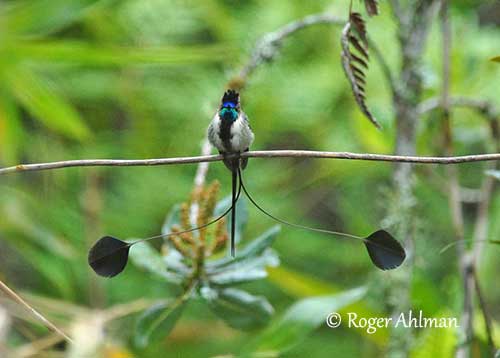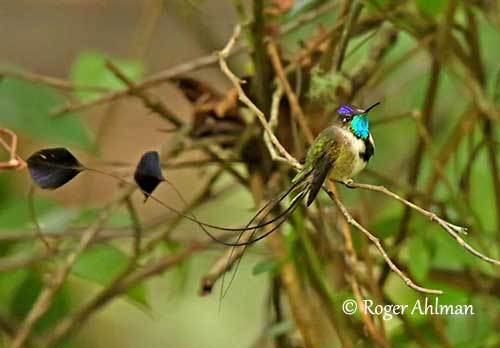
Fr: Loddigésie admirable
Ang: Marvelous Spatuletail
All: Violettscheitel-Flaggensylphe
Esp: Colibrí Admirable
Ita: Spatolino meraviglioso
Nd: Vlagkolibrie
Sd: Spatelstjärt
Photographers:
Roger Ahlman
Pbase Galleries Peru and Ecuador
Ken Havard
My Bird Gallery & Flickr gallery 1 & Flickr gallery 2
Text by Nicole Bouglouan
Sources:
HANDBOOK OF THE BIRDS OF THE WORLD Vol 5 by Josep del Hoyo-Andrew Elliott-Jordi Sargatal - Lynx Edicions - ISBN: 8487334253
BIRDS OF PERU by Thomas S. Schulenberg, Douglas F. Stotz, Daniel F. Lane, John P. O’Neill, Theodore A. Parker III – Princeton University Press 2007– ISBN: 978-0-691-13023-1
THE AVIANWEB - Beauty of Birds (Sibylle Faye)
Wikipedia, the free encyclopaedia
CREAGUS@Monterey Bay (Don Roberson)
Neotropical Birds – Cornell Lab of Ornithology
Marvelous Spatuletail
Loddigesia mirabilis
Apodiformes Order – Trochilidae Family
INTRODUCTION:
The Marvelous Spatuletail is endemic to Peru and one of the most beautiful and spectacular Peruvian hummingbird.
The male exhibits a long tail with only four feathers, including two long racket-shaped outer rectrices. These peculiar ornaments cross each other and can move independently. There is a large violet-blue disc or “spatule” at the end of each feather. The tail is used in courtship displays while the male hovers in front of the female.
The Marvelous Spatuletail is a rare bird, threatened by deforestation for marijuana and coffee plantations. The male is hunted for its heart that is believed to have aphrodisiac properties. The species is currently listed as Endangered.

DESCRIPTION OF THE BIRD:
Biometrics:
Length: M: 15-17 cm including the tail of 11-13 cm – F: 9-10 cm including the tail of 5-7 cm
Weight: 3 g
The Marvelous Spatuletail male has iridescent green-bronze to bronze-brown upperparts. The flight feathers are blackish.
The underparts are white with conspicuous black vertical line from breast to lower belly. The throat shows a turquoise patch or gorget. Body sides and flanks are green-bronze.
The tail is the main ornament of male’s plumage and includes only four feathers. The outer rectrices are long and reduced to shafts. They are curved and cross each other. At the end, there are two purplish-black rackets or “spatules”. These elongated tail feathers can grow 3-4 times the body’s length. The two remaining feathers are blue, shorter, narrow and straight.
On the head, the crest is deep blue, but may vary to purplish-blue according to the light. The hindneck is brownish. There is a small white postocular spot.
The slightly decurved bill is black. The eyes are dark brown. Legs and feet are black.
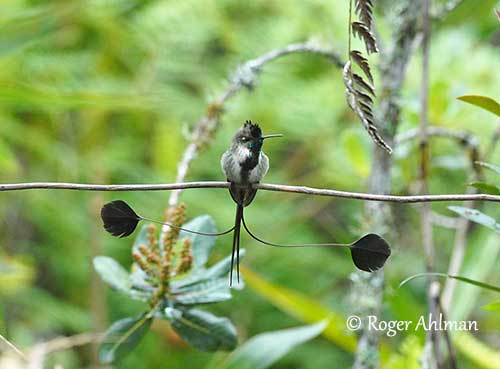
The female has whitish underparts with green speckles. Crest and gorget are absent, and the elongated, but much shorter tail feathers lack the rackets. Breast and belly are buffy-white and the black vertical line is absent. She has mostly bronze-green head and white throat.
The juvenile resembles female.
The immature male has partially developed gorget. On the underparts, the black line is mainly on belly. On the tail, the rackets are blue-black.
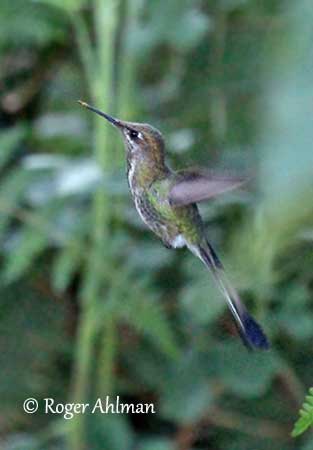
RANGE:
The Marvelous Spatuletail is found in N Peru along the E bank of R Utcubamba in Amazonas. There are some records further E in San Martín.
HABITAT:
The Marvelous Spatuletail usually frequents humid forest edges, second growth and montane scrub of mixed-plant species with patches of thorny vegetation. It forages in these habitats and in dense shrubbery. It also frequents open country, valleys and deep gorges, between 2200 and 2900 metres of elevation.
CALLS AND SONGS: SOUNDS BY XENO-CANTO
The Marvelous Spatuletail produces a peculiar humming and louder flapping noises. The humming noise is produced during the displays, a high-pitched buzzy note “tzzz…tzzz…”
The call is a thin, sweet, rising note “tswee” often repeated in rapid series. We can also hear a strident “tsik”.
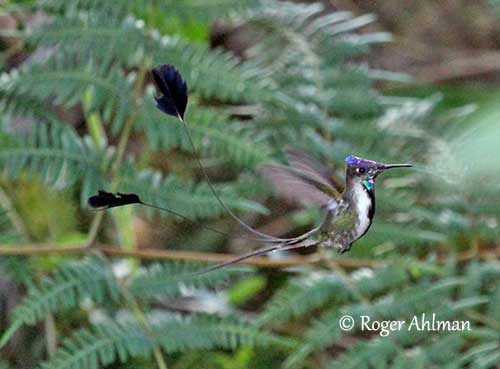
BEHAVIOUR IN THE WILD:
The Marvelous Spatuletail feeds on nectar like numerous Trochilidae species. It feeds primarily on nectar from the red-flowered lily (Bomarea formosissima), but it also feeds at some other flowering plants. During the breeding season, the female also catches insects for the chicks.
It often feeds by perching rather than hovering in front of the flower. It defends its feeding areas against large insects (bumblebees) but it is often displaced by more dominant hummingbird species present in the same habitat.
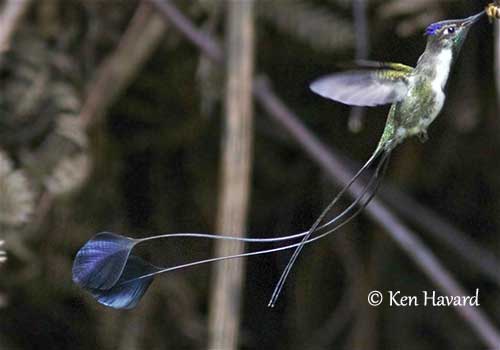
During the breeding season, the adult males gather at leks and displays to attract females. During the displays, the long tail feathers are used to impress the females.
The Marvelous Spatuletail male performs a dance while hovering at high speed and hopping backwards and forwards across a horizontal twig in mid-air. While it is hovering, it waves quickly and crosses its long tail feathers. During these displays, the rackets follow the movement and undulate in the air.
It produces snapping sounds during this behaviour which requires a lot of energy and lasts a very short period of time.
The male is polygamous and the female performs alone the nesting duties.
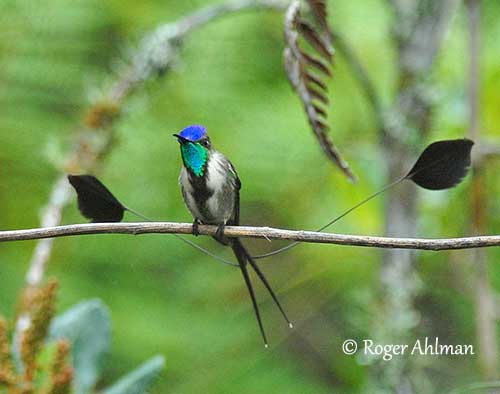
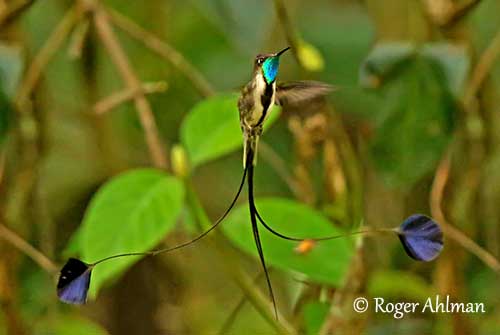
This species is sedentary in its restricted range.
The Marvelous Spatuletail hovers with rapid 8-shaped wingbeats in the horizontal plane. It is able to move in all directions, upwards and downwards, forwards and backwards, and laterally into the air and especially during the courtship displays.
REPRODUCTION OF THIS SPECIES:
The breeding season takes place between late October and early May, during the rainy season.
The female builds a cup-shaped nest by weaving plant fibres. The outer part of the nest is covered with moss, making it almost invisible among the vegetation, usually shrub, bush or tree. The nest is lined with soft plant material such as plant fibres, animal hair and down. The structure is strengthened with spider web and other sticky material. As the chicks are growing, the nest can be enlarged without damage. It is usually placed on low, horizontal branch.
The female lays 2 white eggs and incubates alone during at least two weeks (16-19 days). The male defends the feeding area and the territory. At hatching, the chicks are blind and naked. The female feeds them with regurgitated food including pre-digested insects and broods them. The young leave the nest about 7-10 days after hatching.
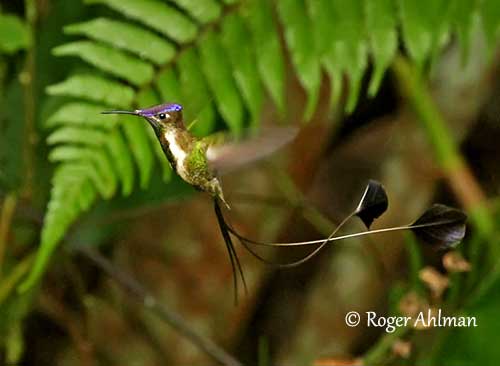
PROTECTION / THREATS / STATUS:
The Marvelous Spatuletail is threatened by deforestation for production of illegal drugs (marijuana) and coffee plantations. However, this species frequents mostly forest edges and isolated thickets on steep slopes, reducing its vulnerability to habitat degradation.
The male is hunted with slingshots for its heart which is believed to have aphrodisiac properties.
The population is estimated at 250/999 mature individuals. The species is generally uncommon within its restricted range.
The Marvelous Spatuletail is currently considered Endangered.
